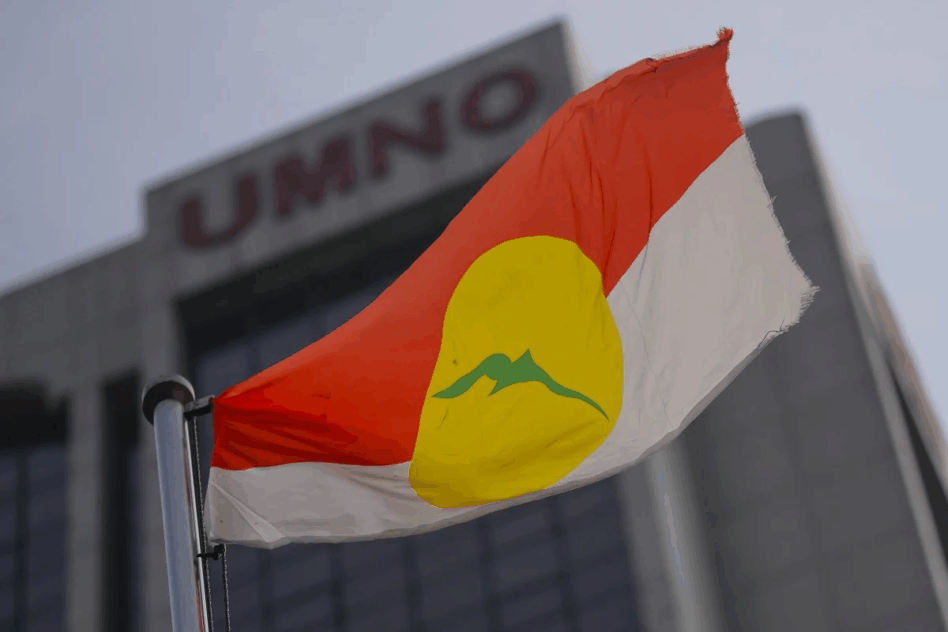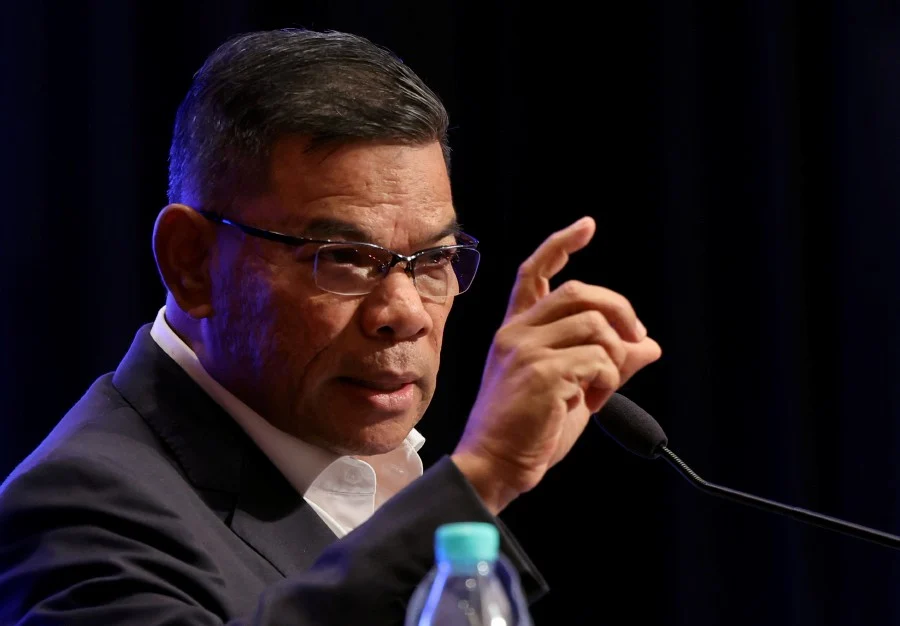THE calendar year 2024 (CY24) advertising expenditure (adex) of RM6.1bil or -7.1% year-on-year (YoY) grossly underperformed compared to Kenanga Research (Kenanga)’s full-year growth assumption of 1.6% YoY.
The disappointment was mainly attributed to weaker-than-expected adex for FTA TV and digital media, as the anticipated seasonal boost from year-end festivities such as school term break, Christmas, and New Year’s Eve failed to materialise.
This quarterly weakness was despite robust YoY growth in Malaysian international tourist arrivals, retail trade, and automotive total industry volume (TIV) in quarter four calendar year 2024 (4QCY24).
 “We believe the lacklustre performance probably stemmed from companies deferring their advertising spend to early CY25, to align with Chinese New Year (CNY) campaigns,” said Kenanga.
“We believe the lacklustre performance probably stemmed from companies deferring their advertising spend to early CY25, to align with Chinese New Year (CNY) campaigns,” said Kenanga.
Recall that CNY in CY25 falls earlier on 29 Jan, vis-à-vis 10 Feb in CY24. Evidently, 4QCY24 adex merely accounted for 23% of full-year adex, a sharp decline from its larger 29% contribution in FY23.
The fall in CY24 industry was primarily attributed to a 33% year-to-date (YTD) dip in digidex.
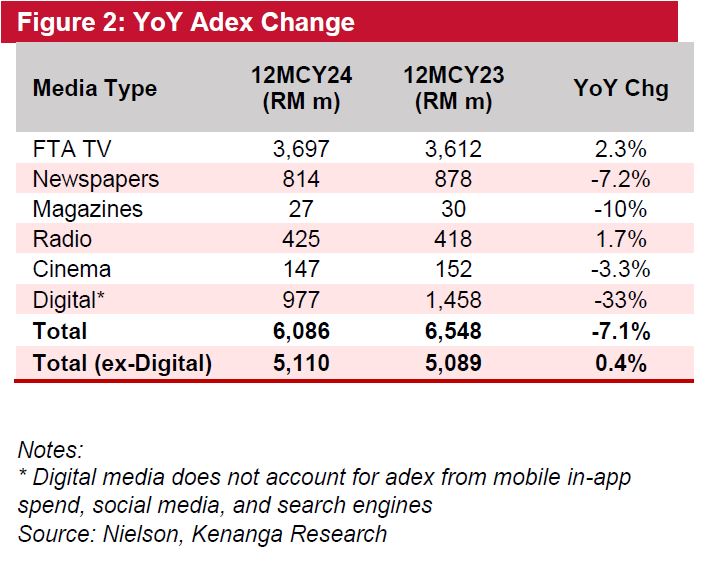
This largely emanated from a sharp downturn in YouTube adex (-32% YTD), possibly due to fierce competition from key opinion leaders (KOLs), social media platforms, and web messaging apps.
The weakness was further compounded by steep adex declines on online websites hosted by Malaysia Kini (-69% YTD) and STAR (-57% YTD).
The sole bright spot was paultan.org, which saw a 28% YTD surge in adex, likely driven by solid TIV, alongside increased car launches and auto shows.
On a more optimistic note, the sequential decline in digidex moderated to 5% in 4QCY24, following steep falls of over 20% for three consecutive quarters since 1QCY24.
To a lesser extent, the plunge in CY24 industry adex was exacerbated by a drop in newspaper adex, particularly for Chinese language publications.

This trend aligns with declines in YTD adex for newspapers published by
(i) MEDIAC: -1%,
(ii) STAR: -11%
(iii) MEDIA: -7%.
On a positive note, CY24 radio adex expanded by 2% YoY, likely driven by renewed interest in certain stations (for example, FlyFM and HotFM) following a refreshed lineup of radio presenters.
Despite a weak 4QCY24, FTA TV ended the year with CY24 adex growth of 2.3% YoY.
On the flipside, YTD adex for MEDIA’s key TV channels, that is TV3, NTV7, 8TV and TV9, was flattish, as higher adex at NTV7 (+35% YTD) was offset by declines across the other channels.
“We believe FTA TV’s sustained popularity is supported by its strong local vernacular content, particularly on TV3, and its large addressable market within the lower-income population segment,” said Kenanga.
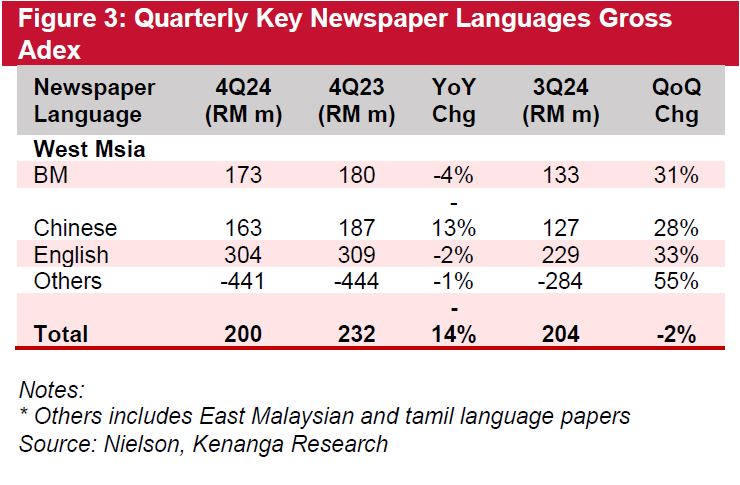
Notably, as reported by Berita Harian, Khazanah Research Institute (KRI) is challenging Malaysia’s household classification, asserting that only the top 30% of households are genuinely middle-income or aspirational.
This contrasts with the government’s view that the top 60%, comprising the M40 and T20 groups, represent the middle class.
“We introduce our CY25 adex contraction assumption of 2.8% YoY, reflecting a milder decline compared to CY24’s contraction of 7.1% YoY,” said Kenanga.
This expectation is underpinned by an anticipated spillover in advertising spend from 4QCY24 into 1QCY25, as highlighted earlier.
In line with this, Kenanga anticipate that declines in CY25 adex for digital media (-25% YoY), newspapers (-5% YoY), magazines (-8% YoY) and cinema (-3% YoY) will more than offset growth in FTA TV (+3% YoY) and radio (+2% YoY).
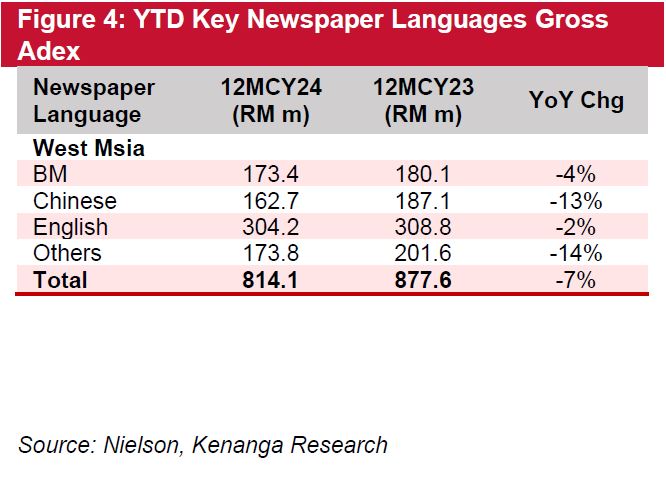
Kenanga believes digidex’s downturn will mainly be driven by ongoing shifts in advertising budgets away from digital media websites toward:
(i) KOLs: via direct brand collaborations and sponsorships.
(ii) Web messaging platforms: via business subscriptions such as WhatsApp Business Platform and sponsored messages such as on Telegram.
This shift reflects the growing popularity of these platforms, underscored by Malaysians exceeding the global average for social media video watch time by 55%, as reported by INSG.
Supporting this trend, Shopee reported that 75% of Malaysian online consumers rely on influencers for solutions and product insights, with 34% considering influencer recommendations before making a purchase.
Additionally, the increasing adoption of ad blockers continues to erode the reach of banner ads, further diminishing the appeal of websites as advertising mediums.
“We maintain our underweight stance on the sector due to persistent top-line pressure from intense competition,” said Kenanga.
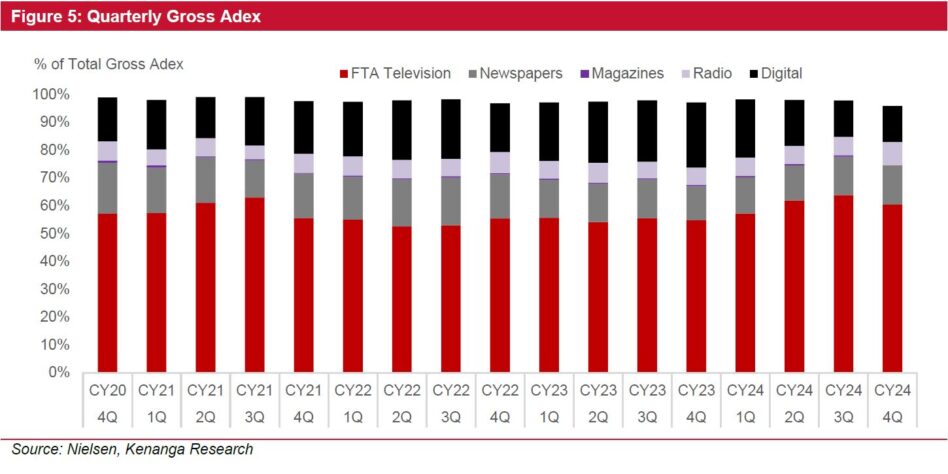
Meanwhile, on the cost side, traditional media companies are burdened with substantial legacy expenditures.
This includes:
(i) newspapers: high costs for newsprint, ink, and distribution logistics.
(ii) FTA and Pay TV: expenses related to maintaining broadcasting infrastructure, such as towers and satellite uplinks.
(iii) inefficiencies of a large, aging workforce with skill sets that are increasingly obsolete in the digital age.
These challenges render it difficult for small legacy media players to remain profitable and compete with new media and KOLs with much leaner and flexible operations.
Meanwhile, larger traditional media companies face earnings volatility, with certain business segments occasionally slipping into quarterly losses.
Looking ahead, a potential catalyst for re-rating that could prompt us to upgrade the sector to neutral is the successful expansion of traditional media players into new media or synergistic businesses.
This would allow them to diversify away from legacy earnings and realize immediate earnings growth.
“We do not have any stock recommendations within the sector,” said Kenanga. —Jan 21, 2025
Main image: Emeritus



